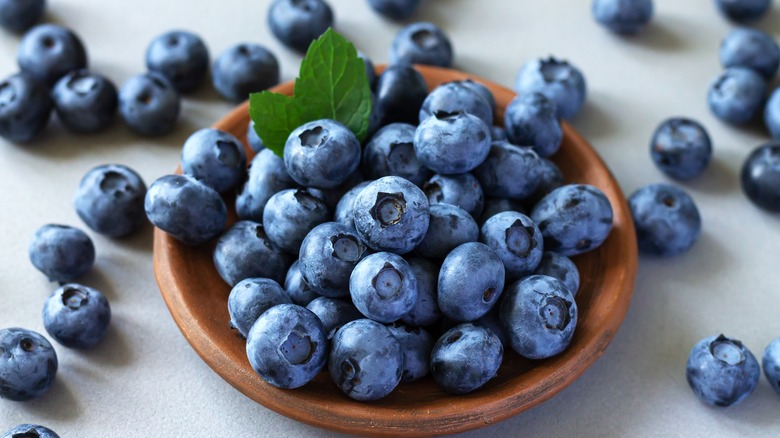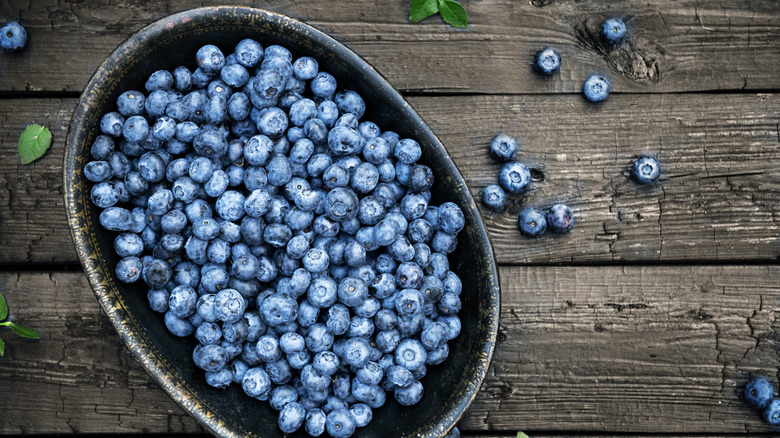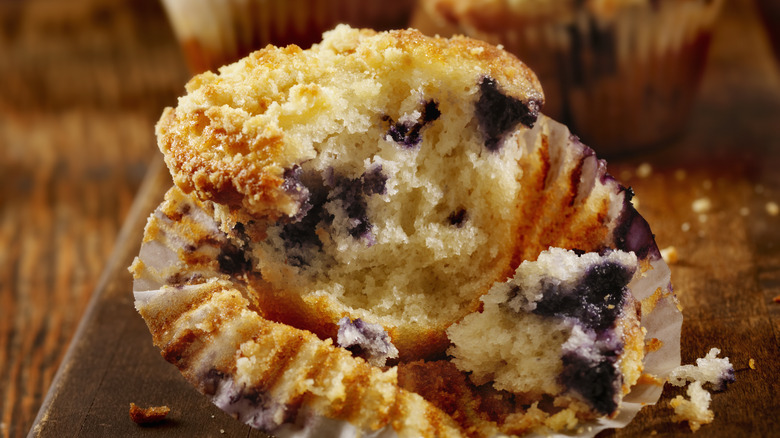False Facts About Blueberries You Thought Were True
Take a closer look at the intriguing world of blueberries as we unravel the mysteries surrounding this beloved berry. You probably think you know some things about these fruits that simply aren't true. In this article, we'll debunk common misconceptions about blueberries that have nestled their way into the collective consciousness.
Contrary to popular belief, blueberry stains aren't impossible to remove, nor are fresh blueberries always better for you than frozen ones. Most surprising of all, perhaps, blueberries aren't actually blue. As we explore these myths, we'll unveil surprising truths about blueberries that you probably didn't know.
Get ready to challenge your assumptions about blueberries. You might find you have some long-held beliefs that are entirely untrue. Join us in this enlightening journey through the false facts surrounding blueberries, as we separate myth from reality and uncover the secrets hidden beneath the surface of these tiny, vibrant fruits. Read on for 13 false facts about blueberries that you thought were true.
False: Blueberries aren't technically blue
Contrary to their name and the immediate visual impression, blueberries aren't truly blue. In fact, blue is an extremely rare color in nature — and one blueberries don't possess. The fascinating science behind their appearance lies in the way that they reflect light. You see, blueberries' primary pigment comes from compounds called anthocyanins. These are actually responsible for red and purple hues. You might have noticed that blueberries appear more deep red or purple once cooked, but why do they look blue when they're raw?
Well, it turns out that the external appearance of blueberries is down to a layer of a waxy substance on their skin. This coating is capable of scattering blue light and UV light while absorbing all other colors of light in the spectrum. This means that our eyes see these berries as blue because it's the only light color reflected into our eyes that we're capable of perceiving. Nobody can be certain of the reason for this adaptation, but it might be to attract birds, who are able to see the scattered UV light. So, while blueberries may not be authentically blue, they appear to be blue because of the way light reflects off their waxy coating.
False: The blueberries in packaged products might not actually be blueberries
Beware of the deceptive allure of the apparent blueberries in some blueberry-flavored packaged products, as the reality often falls far from the truth. Shockingly, what appears to be a scattering of blueberries nestled within your breakfast cereal or muffin mix might be nothing more than an artificial concoction. In an unsettling trend, some processed food manufacturers use imitation blueberries crafted from a blend of sugar, starches, and food coloring rather than real blueberries.
Of course, these products don't incorrectly claim to contain real blueberries. If you check the label, the ingredient list might call them something like "blueberry pieces" or "blueberry crunchlets." However, manufacturers are betting on the fact that a lot of people simply don't read labels.
This concerning practice highlights the importance of scrutinizing ingredient lists and understanding the source of the components in processed foods. As consumers, being vigilant about deceptive marketing practices ensures that we make informed choices about the foods we consume, steering clear of the illusionary blueberries that are anything but authentic. So, the next time you reach for a product flaunting blueberries, take a moment to investigate the ingredient list, as the vibrant blues might just be a clever play of colors and not the wholesome berries you expect.
False: There's no difference between wild and cultivated blueberries
If you think that wild blueberries and the cultivated blueberries you find in stores are basically the same thing, you're mistaken. Wild blueberries, also known as lowbush blueberries, grow naturally in the wild. These berries belong to the species Vaccinium angustifolium and are characterized by their small size. Unlike their cultivated counterparts, wild blueberries are not intentionally planted; instead, they thrive in natural landscapes, including forests and fields. Although they're native to most of the Northern United States, 95% of the wild blueberries sold in the U.S. are produced in Maine. These wild berries have a distinct flavor profile, offering an intense and complex taste that combines sweetness with a subtle tartness. Their smaller size contributes to a higher skin-to-fruit ratio, enhancing the overall flavor experience.
Highbush or cultivated blueberries are intentionally planted, cultivated, and managed for commercial production. Unlike wild or lowbush blueberries that grow naturally in the wild, highbush blueberries (Vaccinium corymbosum) are cultivated varieties developed through selective breeding and agricultural practices. These cultivated blueberries are the predominant type found in grocery stores and are a result of ongoing efforts to enhance their size, yield, and adaptability to various growing conditions. Not only are cultivated blueberry bushes larger in size compared to their wild counterparts, often reaching heights of 6 to 8 feet, but the fruits are larger, too. They're about twice the size of wild blueberries, which is part of what makes them so popular.
False: You have to go to Maine to buy wild blueberries
Yes, it's true that Maine produces around 95% of the U.S. supply of commercially available wild blueberries. It's also true that there's only one harvest of wild blueberries per year and they are also highly perishable. This means that if you want fresh wild blueberries, you'll have the best luck finding them at farmer's markets and in small stores in Maine and surrounding areas from late July to early September.
However, this certainly doesn't mean you have to go all the way to Maine to buy them. They're primarily sold frozen, which means they can be transported all over the country without spoiling. It also means you can buy them year-round, not just in their peak harvesting season. So, all you fans of wild blueberries don't need to go without. Just head to a supermarket freezer aisle to stock up.
False: You can only use blueberries in sweet recipes
It's a common misconception that blueberries are only good in sweet dishes. These versatile berries can bring their flavor and texture to a variety of savory recipes. In fact, there are some ingredients blueberries pair well with that you really wouldn't expect. Incorporating blueberries into savory dishes introduces a blend of sweetness and tartness. There are a wide range of savory recipes that use blueberries, but here are a few ideas for you.
One great savory application is blueberry BBQ sauce. It combines the natural sweetness of blueberries with the smoky and tangy elements of a classic barbecue sauce. Or for a more sophisticated twist, consider flatbreads topped with goat cheese and blueberries. The creamy tang of goat cheese complements the sweetness of the blueberries, giving you a lovely balance of flavors.
Blueberries can also be featured in refreshing salads, offering a burst of color and juiciness. A salad with mixed greens, feta cheese, walnuts, and a handful of fresh blueberries is both vibrant and tasty. Another innovative option is roasted blueberry and beet bruschetta. Roasting blueberries intensifies their flavor, making them a perfect addition to the earthy notes of roasted beets. Spread over crusty bread, this savory bruschetta combines the sweetness of blueberries with the robust flavors of roasted beets.
False: Fresh blueberries are always better for you than frozen blueberries
Think that fresh blueberries obviously better for you than frozen berries? Think again. Contrary to popular belief, frozen blueberries boast higher concentrations of anthocyanins, potent antioxidants responsible for the berries' vibrant hues. Of course, fresh blueberries are still more than adequately nutritious, but their frozen counterparts do have this noteworthy advantage. The higher anthocyanin concentrations in frozen blueberries can contribute to enhanced antioxidant activity, potentially conferring increased health benefits. This revelation challenges the prevailing notion that the fresh variant reigns supreme in nutritional value.
Ultimately, whether opting for fresh or frozen blueberries, incorporating these nutrient-rich berries into one's diet remains a wise choice. The myth surrounding the superiority of fresh blueberries unravels when considering the potential antioxidant boost offered by frozen berries.
Essentially, both fresh and frozen berries are great, so just choose whichever form is more convenient for you and fits your preferences. If you only like to eat your blueberries straight out of the carton, fresh berries have better taste and texture. However, if you mostly put them in pancakes or blend them into smoothies, you might find it more convenient to always have a supply in the freezer.
False: Blueberries will ripen more after picking
While some fruits will ripen more at the store or in your fruit basket, blueberries aren't like this. Once they've been picked, they basically won't get any riper. Whether hand-picking blueberries in the field or perusing them at the store, selecting ripe ones is important, as they won't mature further.
So, how do you know when blueberries are ripe? Look for a uniform deep blue or purple color across the berry's surface. This consistent hue signifies optimal ripeness, as blueberries tend to sweeten as they attain their full coloration. Avoid berries with green or red undertones, as they may not have reached their peak flavor. Additionally, when buying in stores, opt for containers where the majority of berries share a consistent size and color. This uniformity suggests a simultaneous ripening process, so they should all be equally tasty.
If you end up with under-ripe blueberries, don't worry. If they're still fully green, they'll be quite sour, so don't attempt to eat them as-is. Instead, you can turn them into a type of vinegar called verjus. If your blueberries are almost ripe, they won't be hugely sour, but they won't be as sweet as you'd expect. In this case, you can use them in baked goods. Just add some extra sugar to balance out their lack of sweetness.
False: Blueberries can prevent cardiovascular disease
While blueberries have earned a reputation as a superfood and are often associated with various health benefits, it's crucial to approach these claims with a degree of realism. One widely touted potential advantage is their supposed ability to prevent cardiovascular disease. However, a comprehensive review and analysis of controlled trials, published in the National Library of Medicine, tempered these expectations.
The findings of this systematic review emphasized that the current body of evidence is insufficient to conclusively demonstrate that blueberries can significantly reduce the risk of cardiovascular disease. While blueberries undeniably boast a nutrient-rich profile and offer various healthful compounds, their impact on specific health outcomes, such as cardiovascular health, may not be as straightforward as initially thought.
It's essential for individuals to appreciate blueberries for what they are — a delicious and nutritious fruit packed with vitamins, antioxidants, and fiber. While they contribute positively to overall well-being, expecting them to be a panacea for specific health concerns might be overstated. Embracing a balanced and varied diet, complemented by a range of nutrient-rich foods, remains a key tenet of promoting cardiovascular health and overall wellness.
False: There's only one type of cultivated blueberry
Many people think that there's only one type of cultivated blueberry, but the reality is that many cultivars or varieties exist, each with distinct characteristics. This is a bit like the different types of tomatoes or apples available. When considering growing blueberries in your yard, it's valuable to explore popular varieties catering to different preferences and growing conditions.
Aurora, known for its large and sweet berries, is a favorite among home gardeners. Blue Gold, on the other hand, is prized for its exceptional flavor and versatility. Last Word is celebrated for its resilience, thriving in various climates. Elliot is a late-season cultivar, offering a prolonged harvest window, while Earliblue lives up to its name by providing an early-season yield.
Choosing the right blueberry variety involves several considerations. Firstly, assess your local climate — some cultivars are better suited to specific temperature ranges. Additionally, consider the intended purpose of your blueberries. Some varieties are delicious eaten fresh, while others are better suited for baking or processing. Soil conditions play a crucial role; blueberries prefer acidic soils, so it might be a good idea to evaluate your garden's pH levels. Another factor is the size of the mature plant — ensure it works with the amount of available space you have. Lastly, cross-pollination is a consideration; some cultivars yield better results when planted alongside compatible varieties.
False: Eating blueberries will definitely raise your blood sugar levels
While the natural sweetness of blueberries might suggest a potential spike in blood sugar, this may not be the case. This is because blueberries contain compounds called polyphenols that have the ability to stimulate insulin secretion. Insulin is the pivotal hormone in blood sugar regulation, as it facilitates the transportation of sugar from the bloodstream into cells, contributing to stable blood sugar levels. In essence, the polyphenols found in blueberries seem to play a role in this delicate balance, potentially aiding in the regulation of average blood sugar levels.
This unexpected dynamic challenges the conventional notion that sweet foods inherently lead to blood sugar imbalances. Instead, blueberries with their polyphenol content might help maintain blood sugar stability. While individual responses may vary, incorporating blueberries into a balanced diet could offer a flavorful and health-conscious way to support overall blood sugar management. So, keeping your blood sugar stable isn't just about avoiding sugar but about choosing the kinds of sugary foods you eat.
False: You can't forage wild blueberries
If you thought the "wild" in wild blueberries was a misnomer and that you could only buy them from the store, prepare to be pleasantly surprised. You can, in fact, pick blueberries in the wild, assuming they grow where you live. Foraging for wild blueberries is an enjoyable experience, giving you a chance to connect with nature. But there are some things to keep in mind if you want a successful foraging trip.
First, make sure to choose the right location. Wild blueberries thrive in a range of ecosystems, including forests, meadows, and even coastal areas. Research your local region to identify suitable locations. You also need to get the timing right. Blueberries typically ripen in the summer months, with peak harvesting times varying by region — although it's usually between July and August. Keep an eye on local weather patterns and ask seasoned foragers or farmers for optimal picking times.
You also need to be able to identify a blueberry bush. Familiarize yourself with the appearance of wild blueberry bushes. They are low-growing, ranging from roughly 6 to 12 inches tall. The leaves are small and green, with an elongated oval shape. They have short stems or no stems. The berries look like regular blueberries but are smaller in size, so they're hard to mistake for anything else.
False: Pruning blueberry bushes will remove the fruit
Pruning blueberry bushes may initially seem counterintuitive to a bountiful harvest, but when done correctly, it's a crucial practice that enhances the overall health and productivity of the plant. Pruning opens up the bush, allowing better air circulation. Improved airflow reduces the risk of diseases, such as fungal infections, and promotes a healthier environment for the blueberry plant.
Trimming away excess growth also allows sunlight to reach lower branches and the center of the bush. Blueberries require ample sunlight for optimal fruit production. Plus, pruning encourages the growth of new, vigorous branches. These fresh shoots are more likely to bear fruit, leading to a more abundant harvest in subsequent seasons.
The ideal time for blueberry pruning is late winter to early spring, while the plant is still dormant. Aim to prune before new growth emerges, but after the harshest winter weather has passed. Begin by cutting out the twig-like growth around the base of the bush and inside the plant. This won't produce quality fruit and takes energy from the plant that could be elsewhere. Also, remove all dead branches and stems. Next, look at the canes. Leave any healthy, red canes, but consider removing older, browner ones. Just don't prune more than three canes in one go.
False: Blueberry stains can't be removed
Blueberry stains are notorious for their stubborn nature. In fact, it's commonly believed that they just can't be removed. However, they can be effectively banished with the right techniques and household items. If you've fallen victim to a blueberry mishap, here are some remedies that can come to your rescue.
Vinegar and lemon juice are two household items that may help to remove stubborn stains. The acidic nature of both of these substances proves effective against blueberry stains. They're best applied as a pre-treatment for stains, before washing them as usual. For washable fabrics, pouring boiling water through the fabric from a height can sometimes flush away the stain before washing. This is especially effective if you get to it right away when the juice is still wet.
Then, there are enzyme-based stain removers, readily available in stores, which are specifically designed to break down organic stains like blueberries. Follow the product instructions for optimal results. Oxygenated bleach, a gentler alternative to chlorine bleach, can also be mixed with water to create a stain-fighting solution. Ensure the fabric is bleach-safe before application. Finally, for stains on carpets or upholstery, commercially prepared carpet cleaners can be a reliable option. Always test on a small, inconspicuous area first. In all cases, prompt action is key when dealing with stains. But if you act quickly and use the right products, you can absolutely remove blueberry stains.













